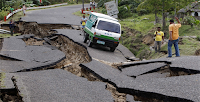Earthquakes and Tsunamis
 Earthquakes and tsunamis are both caused by seismic waves caused by the friction of rubbing tectonic plates. Even though they may seem different they are actually very alike. You can learn more about them in this report.
Earthquakes and tsunamis are both caused by seismic waves caused by the friction of rubbing tectonic plates. Even though they may seem different they are actually very alike. You can learn more about them in this report.How Are Earthquakes Formed?
Earthquakes are formed when two tectonic plates rub against each other. Because the edge of the plates are very rough and bumpy, they rub against each other producing seismic waves that make the ground shake and may cause cracks in the ground to form. The strongest ever recorded earthquake was in Chile, 1960, measuring 9.5 magnitudes. A earthquake of 11 magnitude would rip the earth into two.
How Are Tsunamis Formed?
Tsunamis are formed when undersea earthquakes, which typically occur at boundaries between Earth's tectonic plates, cause the water above to be moved up or down. Tsunamis are formed as the displaced water, which acts under the influence of gravity, attempts to find a stable position again.
Asteroid impacts can also disturb the water above causing a tsunami.
Earthquake Facts
1. A massive 8.8 earthquake in Chile moved the city of Concepción 10 feet to the west on February 27, 2010. This quake also shortened Earth's day and slightly changed the rotation of the planet.
2. In Japan mythology, a giant catfish called Namazu is responsible for earthquakes.
3. In ancient Greece, people believed that the god of the sea, Poseidon, caused earthquakes. When he was angry, Poseidon would strike the ground with his trident and set off an earthquake. His unpredictable, violent behavior earned him the nickname “Earth-Shaker.”
4. In Hindu mythology, Earth is held in place by eight gigantic elephants, all balanced on the back of turtle, which itself stands on the coils of a snake. If any of these animals shift or move, an earthquake occurs.
5. Tectonic plates move less than 3 inches (17 cm) per year. However, a tectonic plate movement of just 20 cm is enough to set off a major earthquake, such as the 6.9 Kobe earthquake in 1995.6. Earthquakes can set off volcanoes, as was the case in the 1980 Mount St. Helens eruption and the Mount Etna eruption in 2002.
Tsunami Facts
1. A tsunami is usually caused by an earthquake but can also be caused by a volcanic eruption, landslide, rapid changes in atmospheric pressure, or a meteorite.
2. A tsunami is not just one big wave, but a series of waves called a “wave train.” The time period between waves is called the “wave period” and can be between a few minutes and two hours. The first wave is usually not the strongest, and later waves, such as the fifth or sixth, may be significantly larger.
3. One of the largest earthquakes in history occurred over 100 miles off the coast of Chile on May 22, 1960. Just 15 minutes after the 9.5 quake, 80-foot waves struck the coast. Fifteen hours later, tsunami waves struck Hawaii and, finally, 22 hours after the earthquake, the tsunami struck Japan—10,000 miles from where the earthquake took place.4. A “mega-tsunami” is a tsunami with extremely high waves and is usually caused by a landslide. A mega-tsunami occurred at Lituya Bay, Alaska, in 1958, creating the tallest tsunami ever recorded at 1,700 feet (534 m) high. Miraculously, only two people died.
Comments
Post a Comment